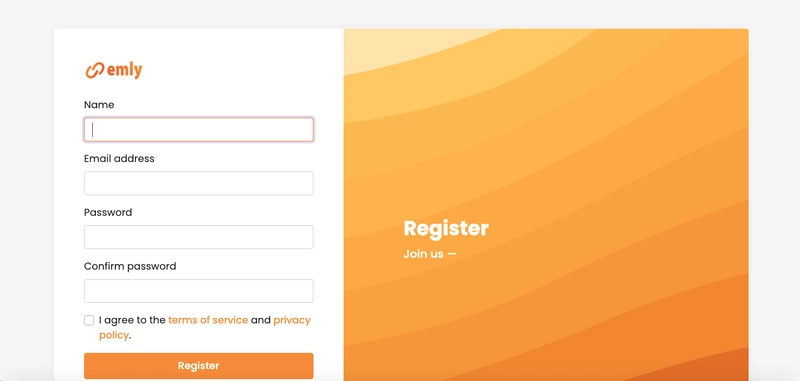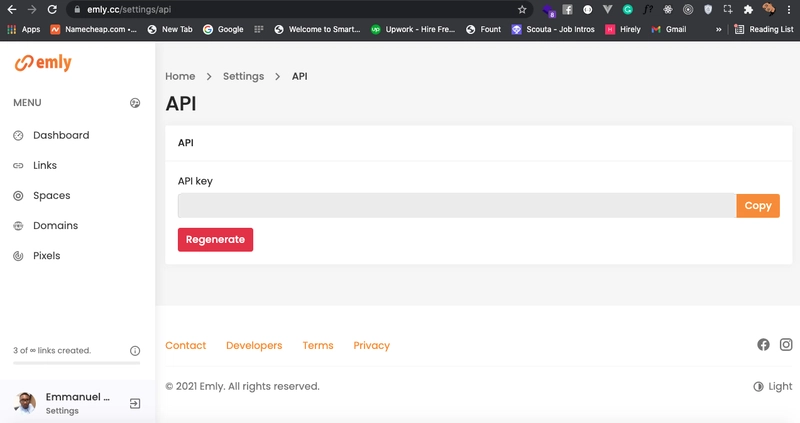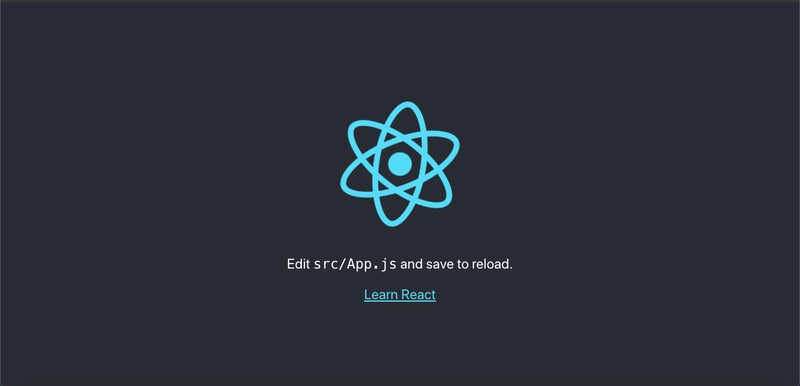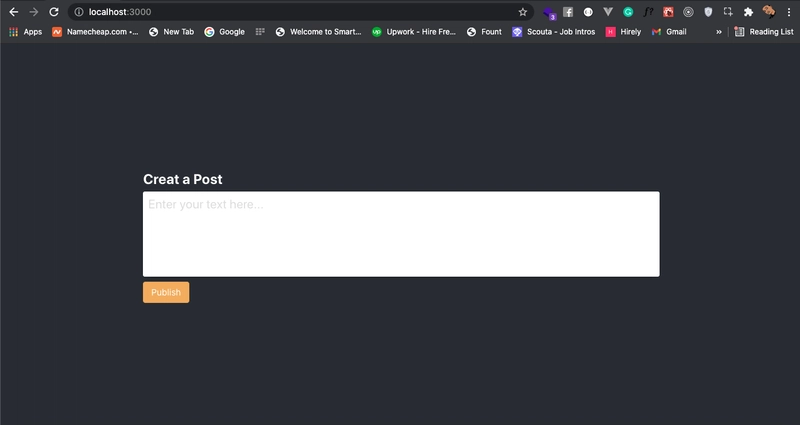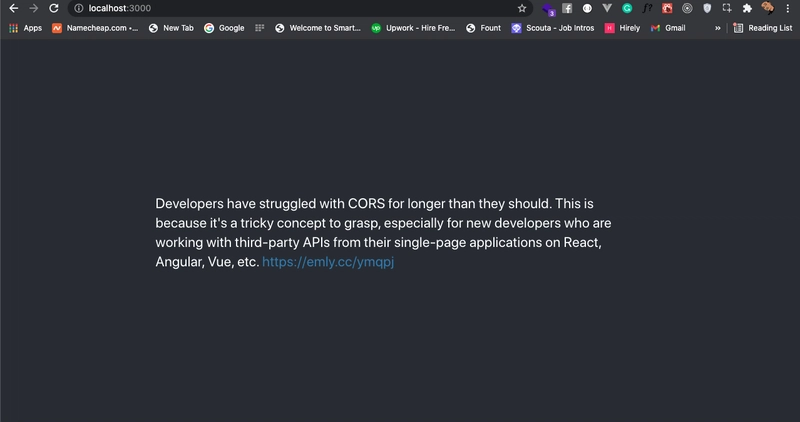使用 react 和 Emly 构建自动 URL 缩短器
自动链接缩短功能正日益流行。顶级科技公司(例如 Twitter 和 LinkedIn)正在利用自动链接缩短功能来缩短那些看起来糟糕的 URL 的长度。Twitter 利用T.co这种技术来缩短在其微博平台上发布的 URL。LinkedIn 也使用同样的技术来缩短其平台上发布的链接。
在本教程中,我们将探讨如何使用Emly.cc在 React 中实现自动链接缩短。
要学习本 React 教程,您应该具备:
- 熟悉 CSS、HTML 和 Javascript ES6
- 您的系统上安装了 Node.js
- 系统中安装的网络浏览器,例如 Chrome
- 安装在开发机器上的代码编辑器,即 VS Code
- 对 React 的基本了解
设置 Emly 帐户
访问http://emly.cc/register创建一个新帐户。
接下来,从仪表板获取 API 密钥。向下滚动到页脚,点击“开发者”,选择链接,然后点击“获取 API 密钥”。参见下方截图:
有了您的 API 密钥,让我们在下一部分继续构建我们的项目。
构建前端
在开始之前,让我们初始化一个新的 React 应用,安装emly-nodejs SDK,并为项目设置一个后端服务器。导航到你的工作目录,并在终端(mac用户终端)或命令提示符(windows用户命令提示符)中运行以下代码,以初始化一个新的 React 项目。
npx create-react-app emly-app
接下来,运行下面的代码来测试运行您的应用程序。
cd emly-app &&
npm start
您的应用程序应该看起来类似于下面的屏幕截图。
接下来,创建一个新文件夹components,导航到该文件夹并创建一个文件ResizeableTextbox.js,然后复制粘贴下面的代码。
import React from 'react';
import axios from 'axios';
class ResizableTextarea extends React.PureComponent {
constructor(props) {
super(props);
this.state = {
post: '',
rows: 5,
minRows: 5,
maxRows: 20,
showPost: false,
newPost: null,
};
this.handelSubmit = this.handelSubmit.bind(this);
this.handleChange = this.handleChange.bind(this);
this.getUrl = this.getUrl.bind(this);
this.replaceUrl = this.replaceUrl.bind(this);
}
replaceUrl = (post) => {
if(!post) return;
var urlRegex = /(((https?:\/\/)|(www\.))[^\s]+)/g;
return post.replace(urlRegex, function(url) {
var link = url;
if (!link.match('^https?:\/\/') ) {
link = 'http://' + link;
}
return '<a href="' + link + '" target="_blank" rel="noopener noreferrer">' + url + '</a>'
})
}
getUrl = (post) => {
var urlRegex = /(((https?:\/\/)|(www\.))[^\s]+)/g;
return post.match(urlRegex);
}
handleChange = (event) => {
const textareaLineHeight = 24;
const { minRows, maxRows } = this.state;
const previousRows = event.target.rows;
event.target.rows = minRows; // reset number of rows in textarea
const currentRows = ~~(event.target.scrollHeight / textareaLineHeight);
if (currentRows === previousRows) {
event.target.rows = currentRows;
}
if (currentRows >= maxRows) {
event.target.rows = maxRows;
event.target.scrollTop = event.target.scrollHeight;
}
this.setState({
post: event.target.value,
rows: currentRows < maxRows ? currentRows : maxRows,
});
};
handelSubmit = (e) => {
e.preventDefault();
let post = this.state.post;
let urls = this.getUrl(post);
var urlRegex = /(((https?:\/\/)|(www\.))[^\s]+)/g;
var self = this;
axios.post('http://localhost:9000/create',
{ url: urls[0] })
.then(function (res) {
if (res.data) {
const url = res.data.data.short_url;
const newPost = post.replace(urlRegex, res.data.data.short_url);
self.setState({
showPost: true,
newPost: newPost
});
}
})
}
render() {
return (
<div className="col-md-8">
{!this.state.showPost && <form onSubmit={this.handelSubmit}>
<label className="form-label">Creat a Post</label>
<textarea
rows={this.state.rows}
value={this.state.post}
placeholder={'Enter your text here...'}
className={'textarea'}
onChange={this.handleChange}
/>
<button type="submit" className="btn btn-warning">Publish</button>
</form>}
{this.state.showPost &&
<div className="card" style={{border: '1px', margin: "20px"}}>
<div className="card-body">
<p className="card-text m-4">
<span dangerouslySetInnerHTML={{__html: this.replaceUrl(this.state.newPost)}} />
</p>
</div>
</div>
}
</div>
);
}
}
export default ResizableTextarea;
从上面的代码片段可以看出,当用户提交表单时,handelSubmit函数会被调用,我们使用正则表达式urlRegex从帖子中搜索 URL,并将其传递给后端服务器,后端服务器随后与 emly.cc 的 API 通信以获取缩短的链接。该replaceUrl函数会再次搜索帖子,这次将缩短的 URL 转换为可点击的超链接。
App.js接下来,使用下面的代码更新代码。
import './App.css';
import ResizableTextarea from './components/ResizeableTextbox';
function App() {
return (
<div className="App">
<header className="App-header">
<ResizableTextarea/>
</header>
</div>
);
}
export default App;
mac接下来,在终端或命令提示符中运行以下代码,以便windows用户启动您的应用程序。
最后,使用下面的代码更新 App.css。
.App-header {
background-color: #282c34;
min-height: 100vh;
display: flex;
flex-direction: column;
align-items: center;
justify-content: center;
font-size: calc(10px + 2vmin);
color: #ffffff;
}
.App-link {
color: #61dafb;
}
.textarea {
box-sizing: border-box;
border: none;
border-radius: 3px;
resize: none;
font-size: 20px;
line-height: 24px;
overflow: auto;
height: auto;
color: #282c34;
padding: 8px;
width: 100%;
box-shadow: 0px 4px 10px -8px black;
}
.textarea::-moz-placeholder {
color: gainsboro;
}
.textarea:-ms-input-placeholder {
color: gainsboro;
}
.textarea::placeholder {
color: gainsboro;
}
.textarea:focus {
outline: none;
}
现在,使用以下命令运行该应用程序。
npm run start
您的应用程序应该看起来类似于下面的屏幕截图。
构建后端服务器
现在您已经完成了项目的前端,让我们继续构建一个可以处理所有后端请求的服务器。
导航到您的工作目录并按照以下说明初始化一个新Nodjs项目。
mkdir emly-server &&
npm init -y
初始化完成后,运行以下代码来安装emly-nodejsSDK和本节所需的其他依赖项。
npm i emly-nodejs body-parser cors dotenv express nodemon
现在,创建一个新文件 index.js,并复制粘贴下面的代码。
require('dotenv').config();
const express = require('express');
const app = express();
const cors = require('cors');
const bodyParser = require('body-parser');
const port = 9000;
const emly = require('emly-nodejs')(process.ev.KEY);
//Body-Parser
app.use(express.json({limit: '50mb'}));
app.use(bodyParser.urlencoded({limit: "50mb", extended: true }));
app.use(bodyParser.json());
//handel cors
app.use(function(req, res, next) {
res.header("Access-Control-Allow-Origin", "*");
res.header("Access-Control-Allow-Headers", "X-Requested-With");
next();
});
app.use(cors({
origin: '*',
methods: ['GET','POST','DELETE','UPDATE','PUT','PATCH']
}));
app.get('/links', (req, res) => {
emly.link.list()
.then(function(body){
res.send(body);
})
.catch(function(error){
res.send(error);
})
})
app.post('/create', (req, res) => {
const {url} = req.body;
emly.link.create({
url: url,
})
.then(function(error, body) {
res.send(error);
res.send(body);
});
})
app.listen(port, () => {
console.log(`Server is listening at ${port}`);
})
注意:请尽量创建一个 .env 文件并添加你的 API 密钥。请参阅下面的示例。
KEY=your_api_key_goes_here
接下来运行下面的代码来启动服务器。
npm run serve
在后端和前端服务器运行后,在文本框中添加带有长 URL 的文本,然后点击“发布”。文章发布后,您的应用应该类似于下面的屏幕截图。
结论
无论您是想为现有的 React 应用程序添加自动URL缩短功能,还是想获得移动/网络应用程序上共享的所有链接的详细分析,emly.cc的 URL 缩短器都可以API在几分钟内为您提供详细的帮助。
 后端开发教程 - Java、Spring Boot 实战 - msg200.com
后端开发教程 - Java、Spring Boot 实战 - msg200.com
